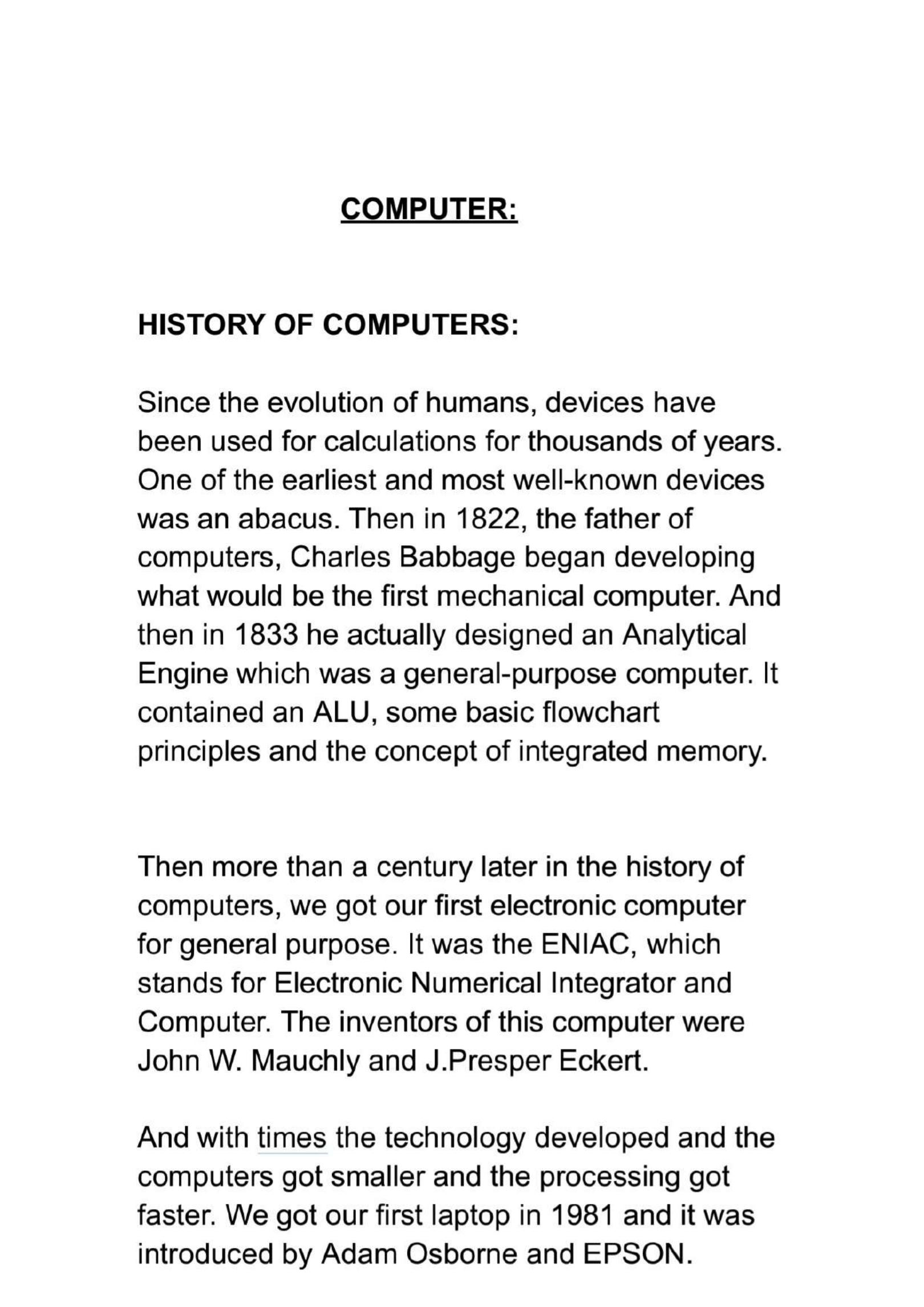Computer composition refers to the process of creating and editing documents using a computer. It involves the use of software programs that allow users to type, format, edit, and share written content electronically.
In today’s digital age, computer composition has become an essential skill for individuals and organizations alike. It offers numerous advantages over traditional pen-and-paper writing, such as increased speed, ease of revision, and the ability to collaborate with others remotely. Moreover, computer composition enables the integration of multimedia elements like images, videos, and hyperlinks into written documents, enhancing their visual appeal and interactive nature.
From writing simple emails to crafting complex reports, computer composition has revolutionized the way we communicate and share information. We will explore the ins and outs of computer composition, including its benefits, popular software programs, and tips for effective and efficient writing in the digital world. So, let’s dive in and unlock the power of computer composition!
History Of Computers
In today’s digital world, computers are an integral part of our daily lives, but the journey of computers started long back. Let’s delve into the fascinating history of this remarkable invention.
Early Computing Machines
Early computing machines date back to the mid-20th century, with the invention of electronic computers. These machines were enormous and relied on vacuum tubes and magnetic drums. Notable examples include the ENIAC, UNIVAC, and IBM 701, marking a significant milestone in the history of computing.
Evolution Of Computers
As technology progressed, computers evolved from room-sized machines to more compact and powerful devices. The development of the microprocessor in the 1970s paved the way for personal computers, leading to a revolution in the computing industry. This evolution laid the groundwork for the modern-day computers that are integral to our personal and professional lives.
Components Of A Computer
Components of a Computer:The components of a computer are the building blocks that work together to enable the functionality of a computer system. Understanding these components can help demystify the inner workings of a computer and allow users to make informed decisions when it comes to purchasing or upgrading a computer. In this article, we will explore the key components of a computer and their roles in its operation.
Central Processing Unit (cpu)
The Central Processing Unit, or CPU, is often referred to as the “brain” of the computer. It is responsible for executing instructions and performing calculations, making it a critical component in the overall functioning of a computer system. The CPU consists of two main elements: the control unit, which manages the flow of data and instructions, and the arithmetic logic unit, which performs mathematical operations and logical comparisons.
Memory (ram And Rom)
Memory plays a crucial role in a computer’s ability to process and store data. There are two main types of memory in a computer system: RAM (Random Access Memory) and ROM (Read-Only Memory).
- RAM: RAM is a volatile memory that temporarily stores data and instructions that the CPU requires to perform tasks. It is called “random access” because data stored in RAM can be accessed in any order, allowing for faster retrieval and processing.
- ROM: ROM, on the other hand, is a non-volatile memory that stores permanent data. It contains firmware that provides essential instructions for booting up the computer and initializing hardware components.
Storage Devices
Storage devices are essential components of a computer system that allow for the long-term storage and retrieval of data. There are two main types of storage devices:
- Hard Disk Drives (HDD): HDDs are mechanical devices that use magnetic storage to store data. They offer high capacity and cost-effectiveness, making them suitable for storing large amounts of data.
- Solid State Drives (SSD): SSDs, on the other hand, use flash memory to store data. They are faster and more reliable than HDDs, but generally come with a higher price tag and lower capacity.
Input And Output Devices
Input and output devices are the means through which users interact with a computer system. These devices enable the input of data and instructions into a computer and the output of processed information.
- Input Devices: Input devices allow users to input data and instructions into a computer system. Examples include keyboards, mice, scanners, and joysticks.
- Output Devices: Output devices, on the other hand, display or output processed information to the user. Common examples include monitors, printers, speakers, and headphones.
Computer Architecture
Computer architecture refers to the structure and organization of a computer system, which includes the hardware components and the way they interact with each other. It plays a crucial role in determining the performance and functionality of a computer.
Von Neumann Architecture
Von Neumann Architecture, named after the renowned mathematician John von Neumann, is a computer architecture design that is used in modern computers. It is based on the concept of storing program instructions and data in the same memory.
In Von Neumann Architecture, the computer system has a central processing unit (CPU) that fetches instructions and data from the memory, performs operations on them, and stores the results back into the memory. This process is known as the fetch-decode-execute cycle, which forms the basis of all modern computing systems.
The Von Neumann Architecture presents several advantages, including its simplicity, flexibility, and ease of implementation. However, it also has some limitations, such as the bottleneck created by the shared memory, which can impact the overall performance of the computer system.
Harvard Architecture
Harvard Architecture is an alternative design to the Von Neumann Architecture. It separates the memory for program instructions and data, allowing simultaneous access to both. This architecture takes its name from the Harvard Mark I, an early computer that implemented this design.
In Harvard Architecture, the computer system has separate memory for instructions and data, each with its own bus for faster and more efficient processing. This allows the CPU to fetch instructions and data at the same time, enabling greater concurrency and performance.
One of the key advantages of Harvard Architecture is its ability to perform simultaneous instruction fetch and data access, which can significantly enhance the execution speed of the computer system. However, this architecture can be more complex to implement and may require additional hardware components.
Summary
In summary, computer architecture is a critical component in the design and functionality of a computer system. The Von Neumann Architecture and Harvard Architecture are two prominent designs that have shaped modern computing. While Von Neumann Architecture allows for simplicity and flexibility, Harvard Architecture enables faster and more efficient processing. Understanding these architectures can provide insights into how computers function and their impact on overall performance.

Credit: collections.vam.ac.uk
Operating Systems
An operating system (OS) is the most vital software that runs on a computer. It manages the computer’s memory, processes, and all its software and hardware. There are various types of operating systems and they serve numerous functions to ensure a smooth device operation.
Types Of Operating Systems
Operating systems can be categorized into several types including real-time operating systems (RTOS), single-user, multi-tasking, and multi-user operating systems.
Functions Of Operating Systems
Operating systems serve several essential functions such as memory management, process management, file management, and security.
Software And Hardware
A computer is comprised of both hardware and software components. The hardware includes physical parts such as the processor, memory, and storage, while the software encompasses programs and applications that run on the hardware. Together, these components form the composition of a computer, enabling it to perform various tasks and operations.
Difference Between Software And Hardware
When it comes to understanding computer composition, it is crucial to distinguish between software and hardware. While they work together to provide the functionality of a computer system, there are fundamental differences between the two.
Software refers to the collection of programs, data, and instructions that tell a computer how to perform specific tasks. It is intangible and exists as a set of electronic instructions stored on various media, such as hard drives, CDs, or flash drives. In simpler words, software can be thought of as the brain of the computer.
On the other hand, hardware refers to the physical components of a computer system. It encompasses all the tangible parts that you can touch and see, including the computer itself, peripheral devices like keyboards and printers, storage devices like hard drives and memory sticks, and various other input/output devices. Hardware can be likened to the body of the computer.
Role Of Software In A Computer System
Software plays a crucial role in the overall functioning of a computer system. It is responsible for coordinating and controlling various hardware components to execute tasks efficiently. Here are some key points highlighting the significance of software:
- Operating System: The operating system, a core component of software, serves as an interface between the user and the hardware. It manages system resources, runs applications, and provides a user-friendly environment for executing tasks.
- Application Software: This type of software includes programs developed to perform specific functions, such as word processors, web browsers, and video editing software. These applications allow users to perform a wide range of tasks on their computers.
- Development Tools: Software also includes development tools that facilitate the creation of new software applications. These tools provide programmers with the necessary resources and libraries to write code and compile it into executable programs.
- Updates and Upgrades: Software updates and upgrades are essential to keep a computer system secure, improve performance, and add new features. These updates ensure that the software remains compatible with the latest hardware and meets the evolving needs of users.
In conclusion, understanding the difference between software and hardware is key to comprehending computer composition. While hardware refers to the physical components of a computer system, software represents the intangible instructions and programs that bring the computer to life. The role of software in a computer system is critical, as it provides the necessary instructions and control to ensure efficient operation.

Credit: collections.vam.ac.uk
Computer Networks
Computer networks are intricate systems connecting multiple devices to share information and resources efficiently. Understanding the composition of computer networks is crucial for optimizing performance and ensuring seamless communication between interconnected devices. Each component plays a vital role in maintaining the network’s functionality and reliability.
Computer Networks connect multiple devices to facilitate communication and resource sharing.Types Of Networks
Local Area Network (LAN): Limited geographic area, like a home or office. Suitable for small businesses. Wide Area Network (WAN): Spans large distances, connecting multiple LANs. Utilizes public or private networks. Wireless Network: Uses radio waves instead of cables for connectivity. Wi-Fi is a common example.Network Topologies
1. Star Topology: All nodes connected to a central hub. Easy to troubleshoot but reliant on central hub. 2. Ring Topology: Each device connected to two others in a circular fashion. Data flows in one direction. 3. Mesh Topology: Every device interconnected with every other device. Redundancy but complex setup. 4. Bus Topology: All devices share a single communication line. Simple but can lead to network congestion.The Future Of Computing
As technology continues to evolve at a rapid pace, the future of computing holds immense potential for groundbreaking advancements. From the revolutionary potential of quantum computing to the increasingly pervasive role of artificial intelligence (AI) in computing, the landscape of computer composition is on the brink of significant transformation.
Quantum Computing
Quantum computing represents a paradigm shift in computational capabilities. Unlike traditional computers, which rely on bits, quantum computers utilize quantum bits, or qubits, allowing for parallel processing and exponential speed in performing complex calculations. This emerging technology has the potential to revolutionize fields such as cryptography, drug discovery, and materials science, ushering in a new era of computational power with profound implications for various industries.
Artificial Intelligence In Computing
The integration of artificial intelligence in computing is poised to redefine the way machines process information and perform tasks. Through machine learning algorithms and neural networks, AI enables computers to analyze vast datasets, recognize patterns, and make autonomous decisions. From enabling predictive analytics to powering autonomous systems, the integration of AI is driving innovation across sectors, from healthcare and finance to manufacturing and beyond.

Credit: issuu.com
Ethical Considerations In Computing
When considering ethical aspects of computing, it is crucial to address the responsible composition of computer systems. This involves ensuring that technology is developed and utilized in a way that respects privacy, data security, and the ethical implications of artificial intelligence.
Staying mindful of the ethical dimensions of computer composition is essential for integrating technology responsibly into society.
When it comes to the field of computer composition, there are several important ethical considerations that need to be taken into account. These considerations play a crucial role in the development and use of computer technologies, ensuring that they are used responsibly and do not harm individuals or society as a whole. Two key ethical considerations in computing are data privacy and cybersecurity.
Data Privacy
Data privacy is a fundamental concern in computing. It refers to the protection of personal information and ensuring that it is not accessed, used, or disclosed without proper authorization. As technology continues to advance, the amount of data being collected and stored has increased exponentially. This raises concerns about the potential misuse of personal information, such as identity theft, fraud, and unauthorized surveillance.
Organizations that collect and store personal data have a moral and legal responsibility to protect the privacy of individuals. Data breaches and leaks can have severe consequences, including financial loss and reputational damage. Therefore, it is imperative for companies to implement effective data privacy policies and practices. This includes obtaining informed consent from individuals, implementing robust security measures, and regularly monitoring and auditing data systems.
Cybersecurity
Cybersecurity is another crucial ethical consideration in computing. It involves the protection of computer systems and networks from unauthorized access, damage, and disruption. With the increasing dependency on technology, the threat landscape for cybersecurity has also expanded. Cyber-attacks, such as hacking, malware, and ransomware, can lead to significant financial losses and compromise the integrity, confidentiality, and availability of data.
Businesses, governments, and individuals must take proactive measures to enhance cybersecurity. This includes regularly updating software and operating systems, using strong and unique passwords, implementing two-factor authentication, and conducting regular security audits. Additionally, educating users about safe internet practices, such as avoiding suspicious links and attachments, can go a long way in protecting against cyber threats.
Moreover, companies should adopt a risk-based approach to cybersecurity, which involves identifying potential vulnerabilities, assessing their impact, and implementing appropriate countermeasures. This ensures that limited resources are allocated to the most critical areas, maximizing the effectiveness of cybersecurity efforts.
Frequently Asked Questions On Computer Composition
What Is Computer Composition?
Computer Composition refers to the arrangement of hardware components in a computer system to ensure proper functionality and performance. It involves assembling various parts like CPU, RAM, and storage devices to create a functioning computer unit.
Why Is Computer Composition Important?
Proper Computer Composition is essential for optimal performance, efficient functioning, and overall usability of the system. It ensures that all hardware components work together seamlessly to execute tasks and run software effectively.
How Can I Optimize Computer Composition For Better Performance?
You can optimize Computer Composition by selecting compatible hardware components, ensuring proper ventilation for cooling, managing cable organization, updating drivers regularly, and removing unnecessary software to enhance the overall performance of your computer system.
Conclusion
In a rapidly advancing digital era, the art of computer composition holds endless promise. From captivating visuals to powerful narratives, the potential for creativity knows no bounds. As technology continues to evolve, so too does the potential for imaginative expression through computer composition.
Embracing these innovative tools unlocks a world of endless possibilities for creators and audiences alike.







